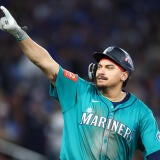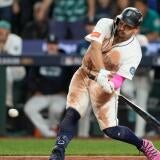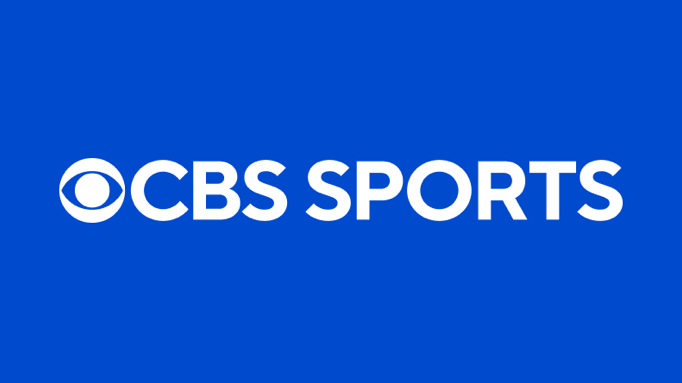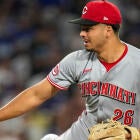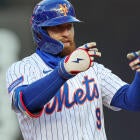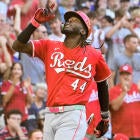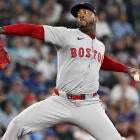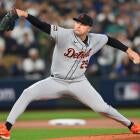Fantasy Baseball Today: Chase Burns, Trey Yesavage lead breakout second-year SP class
Target these second-year breakout arms in 2026

It would be a stretch to say 2025 was "The Year of the Rookie Starting Pitcher" or something like that. There were only six rookie starters who managed 2.0 WAR, per Baseball-Reference's Stathead tool, which was actually tied for the 19th-lowest mark of the past 25 seasons, with only 2001 producing fewer. By that standard, 2025 was actually a pretty historically poor year for rookie starting pitchers.
But those of us who were paying attention know that isn't the whole story. Okay, sure, maybe there weren't many superstar pitchers who racked up huge numbers all season long. But there were plenty of contributors, and that grew more true down the stretch, when names like Cam Schlittler, Cade Horton, Luis Morales, Nolan McLean, Chase Burns, and Jacob Misiorowski emerged as really valuable Fantasy options – and that is by no means a complete list of interesting rookie pitchers.
In fact, the most exciting of the rookies to debut in 2025 may have been someone who barely mattered for Fantasy: Blue Jays pitcher Trey Yesavage. Yesavage just didn't have the time to make an impact for Fantasy, as he was called up in mid-September, in time to make just three starts down the stretch. And yet, no rookie pitcher – heck, maybe no pitcher, period – has put their stamp on the 2025 season's highest leverage moments than Yesavage. And it culminated Wednesday night with one of the greatest starts by a rookie pitcher in World Series history.
Facing the mighty Dodgers, Yesavage was utterly dominant. He struck out 12 over seven one-run innings, his second double-digit strikeout effort of this postseason. And he did it with the whole arsenal – including, shockingly, a dominant slider. We knew Yesavage's splitter was a devastating pitch with the way it tunneled off his four-seamer from that super-high arm slot and tumbled down and out of the strike zone, and he generated an impressive seven swinging strikes on 10 swings with it Wednesday. But the slider was, somehow, even better. He threw that pitch 43% of the time Wednesday and generated 14 whiffs on 29 swings, plus eight batted balls with just an 83.1 mph average exit velocity.
And it's not a one-start fluke, either. Yesavage previously held the Dodgers to two runs over four innings with five strikeouts in Game 1 of the World Series, and he's up to 39 strikeouts and a 3.46 ERA in 26 innings so far in the postseason. That has included a start against a very good Yankees lineup plus a Mariners lineup away from Seattle – the Mariners had the second-best wOBA in baseball on the road this season, by the way.
It's still a small sample size from Yesavage, but we've now seen 55 strikeouts to 17 walks in 40 innings of work from him in the majors, mostly against very tough competition. And he's doing it as a 21-year-old who, you may have heard, started the season at A ball. It would certainly be possible to overreact to that – don't rank him as a top-10 SP for 2026! – but the upside he's showing is obviously worth betting on.
I was planning on doing my "State of the SP Position" piece today, and then I started writing about the rookies and second-year pitchers and realized these guys need the spotlight all for themselves. It's not just Yesavage, of course. There are at least five other pitchers from the 2025 rookie class – either guys who exhausted their rookie eligibility or who will still be rookies in 2026 despite debuting already, like Yesavage – who will be top-150 picks and could sneak into the top 100, and plenty more who are going to be drafted in most Fantasy leagues.
So, before we get to the full breakdown of the SP position next week, let's take a look at the 2025 pitching debuts (and top remaining prospects) you need to know for 2026:
The top second-year SPs to target
Before we get to the specific players, one thing to note: For as much as there is to get excited about with the following 20 or so pitchers, none of them should be drafted with the expectation that they'll be capable of carrying your rotation. In the mock draft we did this week – which I'll be writing about more next week – I took Paul Skenes and Garrett Crochet to start my draft and then didn't even think about taking a third starting pitcher until the 10th or 11th round, when I was going to reach for Chase Burns as my No. 3.
In an ideal world, that's how you'd treat the top tier of these second-year pitchers. As a high-upside No. 3 or 4 SP after you have guys who can stabilize your rotation. These should all be viewed as luxury picks. They are the pitchers you are hoping can take your rotation over the top, not guys you need to carry you. For as talented as they all are, the sample sizes are small across the board, and the risks inherent to any young pitcher are obvious.
Just keep that in mind. Now, let's get excited:
- Chase Burns, Reds – Others might not have Burns at the top of this group, but I'm just such a big believer in him. HBe was one of just 13 pitchers in the majors to have at least four double-digit strikeout games in 2025, and he did it in a span of just five starts. His 5.24 ERA as a starter is a little off-putting, but his 2.47 FIP is more indicative of the upside here, as is his massive 37.8% strikeout rate. He missed a few weeks with an elbow injury but still got to 109.1 innings last season, so there's some runway for him to surpass 150 in 2026, and I think he could be a Hunter Greene/Spencer Strider-esque contributor at his peak. His home park won't provide much help, and homers could be an issue as a result, but I'm expecting something like a mid-3.00s ERA with one of the best strikeout rates in baseball from Burns. We could be talking about Burns as a top-five SP this time next year.
- Nolan McLean, Mets – A 2.06 ERA with 57 strikeouts in 48 innings of work as a rookie? That's what McLean managed last season after his promotion, and that was after he put up a 2.45 ERA in 113.2 innings in the minors, so there shouldn't be any workload concerns here. I don't think he's quite on Burns' level in terms of pure stuff (and he's certainly behind at least one other pitcher further down this list in that regard, too), but McLean has good enough stuff with a deep arsenal that he commanded well. The comp I've gone to most often with McLean is Logan Webb, another groundball with a deep arsenal, but McLean might have even more swing-and-miss potential. The Mets have a well-earned reputation for maximizing pitchers lately, and McLean might already be this team's ace. And, unlike most of the other pitchers here, there's no real injury history or innings limitation to worry about. He could give us 180 great innings in 2026, making him certainly the safest bet among this crop of first or second-year pitchers.
- Jacob Misiorowski, Brewers – Misiorowski took the league by storm early on, and in terms of pure stuff, nobody can match him. But he was a lot less effective after his electric first month and a half, though he did bounce back a bit in the postseason, notably only walking three over 12 innings in three starts. I think he might be the most volatile of these options, mostly because there is just a very limited track record of him being able to throw enough strikes. That's going to limit his efficiency, and I imagine the Brewers are still going to be pretty careful with his workload in 2026, which will lead to some frustratingly brief outings. The Jacob deGrom comps Misiorowski has earned aren't unreasonable, but he could be a frustrating pitcher to rely on if you draft him too high.
- Cam Schlittler, Yankees – I think Schlittler is the last of this tier, all of whom should probably be drafted around the 10th round in most 12-team leagues – and that includes the previously mentioned Yesavage. Schlittler was also the most effective of this group over the largest sample, which includes 14.1 innings of two-run ball in the postseason. Why is he last among this group? Well, I don't know if he has the go-to swing-and-miss secondary everyone else has, and his fastball's excellence seems dependent on his ability to sustain elite velocity – and seeing as he went from averaging 96.5 mph in Triple-A to 98.0 in the majors, that's an open question, in my eyes. I'll grant I might be being unfair there, but I just have slightly bigger questions about Schlittler than the rest of this group – though I do think I would rank him ahead of Yesavage, at least.
- Cade Horton, Cubs – Given Horton's 2.67 ERA over 118 innings as a rookie, I understand if some of you might be pounding the table for him to be included in that previous group. But he isn't on that level for me for a couple of reasons. For one thing, there's the injury track record – he threw just 34.1 innings in 2024 after dealing with multiple arm injuries, meaning he had an innings jump of more than 110 last season. For another … he just didn't earn that 2.67 ERA. Pick your favored ERA estimator, and they all agree he should have been at least a run worse. His xERA was 3.93, which I like to cite because it undercuts the argument that his lack of strikeouts didn't really matter because he generated a lot of weak contact – xERA takes into account quality of contact, and Horton's was about average. He's obviously young enough that he could take a step forward, but I think Horton needs to take a step forward to be anywhere near as effective as he was in 2024 again, and that's not a bet I want to make, especially given the injury history. He'll need to slip past 150th overall in a draft for me to really consider him.
- Logan Henderson, Brewers – Henderson's season came to an end with an elbow injury before he could return to the Brewers' rotation, but he was very effective both in the majors and in the minors. He got to 103 innings and should have a spot in the rotation on Opening Day, and has the potential to be a mid-3.00s ERA pitcher with very good WHIPs, a la a Bailey Ober type. I don't think there's nearly as much upside here with Henderson as the guys ahead of him, but there will also be a lot less hype, making him a viable late-round target.
- Luis Morales, Athletics – Morales was impressive down the stretch, putting up a 3.14 ERA in his 48.2 innings of work, but I wish I could get more excited about him. He throws hard and the stuff passes the eye test, but he was never really a dominant strikeout pitcher in the minors and he missed shockingly few bats as a rookie – as Nick Pollack at PitcherList.com notes, he had just a 7% swinging strike rate with his four-seamer and just a 9.5% rate overall, around what Zac Gallen and Brandon Pfaadt managed last season. There should be more strikeout upside here, but he needs to unlock it. However, his home park could lead to some untenable growing pains.
- Zebby Matthews, Twins – I like Zebby. His biggest flaw is an inability to limit hard contact, as his .430 expected wOBA on contact was the seventh worst among pitchers with at least 300 PA against in 2025. He does everything else pretty well, though, and quality of contact is one of those things that tends to fluctuate a lot from one season to the next. His slider is a very good pitch both in terms of missing barrels and bats, and his command is good enough that I think he can take a step forward with a few tweaks – he might benefit from strategically throwing to the edge (and even outside!) of the zone more often. Matthews is by no means a sure thing to improve, but he'll be on a lot of my teams as a bet that he can make the tweaks necessary.
Top rookies to know for 2026
These guys are ranked more or less in order of how likely it is they'll be on their team's Opening Day roster:
- Bubba Chandler, Pirates – Chandler stumbled in the second half and then was merely fine in his seven appearances in the majors, but it doesn't really seem like anyone has cooled on him. He'll be one of the more popular breakout picks in the game, though he'll need his breaking balls to play better as swing and miss pitches to truly live up to his upside.
- Andrew Painter, Phillies – 2025, did not go well for Painter, but it seems like a lot of prospect folks are going to give him the benefit of the doubt for his first season coming back from Tommy John surgery. He got through 118 innings without incident, which is the most important thing. But he didn't generate nearly as many swings and misses as expected and is giving me Jackson Jobe or Shane Baz vibes these days. He certainly no longer feels like the can't-miss guy he was promised to be. Which makes sense: He's a pitcher.
- Parker Messick, Guardians – Messick made it to the majors with a lot less hype than some other pitching prospects who debuted late, but he continued to do what he does at every level: Get outs. Messick gives me real Matthew Boyd vibes, and while I think it's unlikely he'll ever be the difference maker some of these other guys could be, I think he's got a very high floor for a young pitcher. Also: I'm a sucker for a lefty with a sick changeup, and Messick has one. I expect his 31.2% whiff rate with that pitch to tick up a bit in 2026, too.
- Trey Yesavage, Blue Jays – Yesavage locked his spot in the Blue Jays rotation on Opening Day up thanks to his postseason, which has seen him rack up 27 strikeouts in 19 innings. You don't often see righties described as funky or crafty, but I think that fits here, thanks to Yesavage's super-high release point and killer splitter. There aren't a lot of pitchers who look like Yesavage, and I think that plays to his benefit – hitters just aren't used to seeing this combo of pitches come from that arm slot. His lack of glove-side movement might become an issue with same-handed hitters – righties had an OPS nearly 200 points higher than lefties against Yesavage this season, including the minors – but that's a relatively minor concern, all told. And if he can use the slider like he did Wednesday in his brilliant World Series start against the Dodgers – where he generated a whopping 14 swings and misses with that pitch alone – then he might just be an ace.
- Brandon Sproat, Mets – Sproat was awful early in the season, but took a big step forward from July on. There was a bit of a velocity jump, and he spent much of the season tweaking his pitch mix, eventually landing on the mix that got him to the majors. He threw all six of his pitches at least 5% of the time against righties and threw five pitches at least 16% of the time to lefties, so it'll be a deep arsenal, though I'm not sure it'll necessarily be an overpowering one. Lance Brozdowski has comped Sproat to Brandon Pfaadt, and I can see it – which doesn't exactly excite me, to be honest.
- Robby Snelling, Marlins – Snelling saw his stuff tick up in 2026, but even for a lefty, that mostly only pushed him to the above-average side of average. He has thrived in the minors more on command than pure stuff, and if his velocity dips back to where it was in 2024, there's a lot less to be excited about here. But he probably has a pretty high floor and should at least be useful, though his team won't buoy his value much, unfortunately.
- Connelly Early, Red Sox – With 29 strikeouts in 19.1 innings to open his career, Early has to have done enough to pitch his way into the Red Sox's Opening Day rotation. I'm not sure he has the stuff to necessarily sustain the sky-high strikeout rate, though there's plenty to like in his varied and deep pitch mix from the left side. If he settles into the double-digit rounds in ADP, he'll be a fine pick, though I suspect there will be some drafters who are so enamored with his late-season success that they'll reach.
- Jonah Tong, Mets – Tong is going to be super controversial in drafts, and there will be some folks who are just completely out on him after he looked overmatched in his brief time in the majors. Honestly, I thought his bizarre delivery would help him take the league by storm in the first look, but his command just wasn't good enough for that. The vert-heavy fastball should pair well with his changeup, and it's not hard to envision a world where Tong out-pitches Trey Yesavage with a similar approach, though obviously Yesavage needs to be ranked ahead given how their first taste of the majors went. But I still like Tong plenty and expect to make him a priority late-round target in 2026 drafts if it looks like he's going to be on the Opening Day roster – no guarantee of that, of course.
- Payton Tolle, Red Sox – Tolle might have the single-best pitch of anyone on this list. He's massive at 6-foot-7 and generates huge extension with his delivery, which allows his mid-to-high-90s fastball from the left side to play up as a monster at the top of the zone. He generated a whiff on 29.2% of swings against it in the majors despite struggling overall, and that's a heck of a base to build an arsenal around. The rest of the arsenal was not nearly as impressive, especially against major-leaguers, and I'm not sure anything else here rates out above average. The Red Sox have a recent, but well-earned, reputation for developing young pitchers, and they'll surely spend the offseason working on the secondaries to try to find the right mix. He'll be another high-priority late-round target for me.
- Thomas White, Marlins – White is probably a pretty long shot to make the Opening Day rotation, but we should see him at some point this season after he reached Triple-A in 2025 while putting up a 2.31 ERA and 38.6% strikeout rate across three levels in the minors. His command needs to be tightened up, but the surface-level and advanced stats are in agreement that he should be a difference-making pitcher before long. Expect an early-Summer debut and a lot of excitement for White.
- Liam Doyle, Cardinals – There could be a similar path for Doyle that we saw with Chase Burns and Paul Skenes, two other pitchers who debuted less than a year after being drafted out of college. I don't think Doyle is on either's level as a prospect, but that's no knock on him, as Burns and Skenes have top-five SP upside, in my view. Doyle's arsenal starts with an excellent high-90s fastball from the left side, and his slider, sweeper, and splitter all generated above-average whiff rates in college. He slots in just ahead of Kade Anderson, one of the two pitchers drafted ahead of him, because the path to a rotation spot in St. Louis looks a lot more clear than the one in Seattle.
- Kade Anderson, Mariners – Anderson got up to 119 innings at LSU last season and racked up huge strikeout numbers with strong control, though the stuff isn't quite as impressive as it is with Doyle, who sits a few mph higher. But Anderson is in an organization that has maximized their top pitching prospects in recent years, and his big workload in 2025 means there should be fewer innings limitations than with most top prospects when he gets the call. If the Mariners do opt to trade Castillo this offseason, that could be a hint that they expect Anderson to move very quickly.
- Tyler Bremner, Angels – Bremner was actually taken ahead of Doyle and Anderson, but he wasn't nearly as dominant as either in college and doesn't tend to be viewed as the best prospect among them. Very Angels stuff, no? Of course, there's another very-Angels thing to highlight here, which is that they tend to be extremely aggressive with their promotions, so it wouldn't be especially surprising if he debuted before either of them. I just don't think there's the same upside with Bremner, who either needs his fastball to take a step forward or his breaking ball to become a more consistent weapon – right-handed pitchers whose best secondary is a changeup aren't a prospect archetype I tend to like to bet on without outlier skills. But his likely proximity to the majors makes him worth keeping on your radar for 2026.
- Jarlin Susana, Nationals – Susana could be the next Hunter Greene. He has that kind of stuff, including a slider that could be a plus-plus pitch and some of the absolute best fastball velocity in organized baseball. He's also struggled with his health, including a UCL sprain this summer, and walked 14% of hitters last season. It's a boom or bust kind of profile, but he might have as much strikeout upside as any pitcher in the minors and has already held his own at Double-A, so there's a real chance we see him at some point in 2026, if not early.
- Travis Sykora, Nationals – We've got a really limited sample size with Sykora, who has thrown just 130.1 innings since being drafted in the third round in 2023. But they've been pretty dominant innings, with a 2.14 ERA and 41.8% strikeout rate, and he even made a couple of starts at Double-A after overcoming hip and triceps injuries. There's some risk here, but he also might be only a couple of good months away from proving ready if he can stay on the mound and keep dominating.




